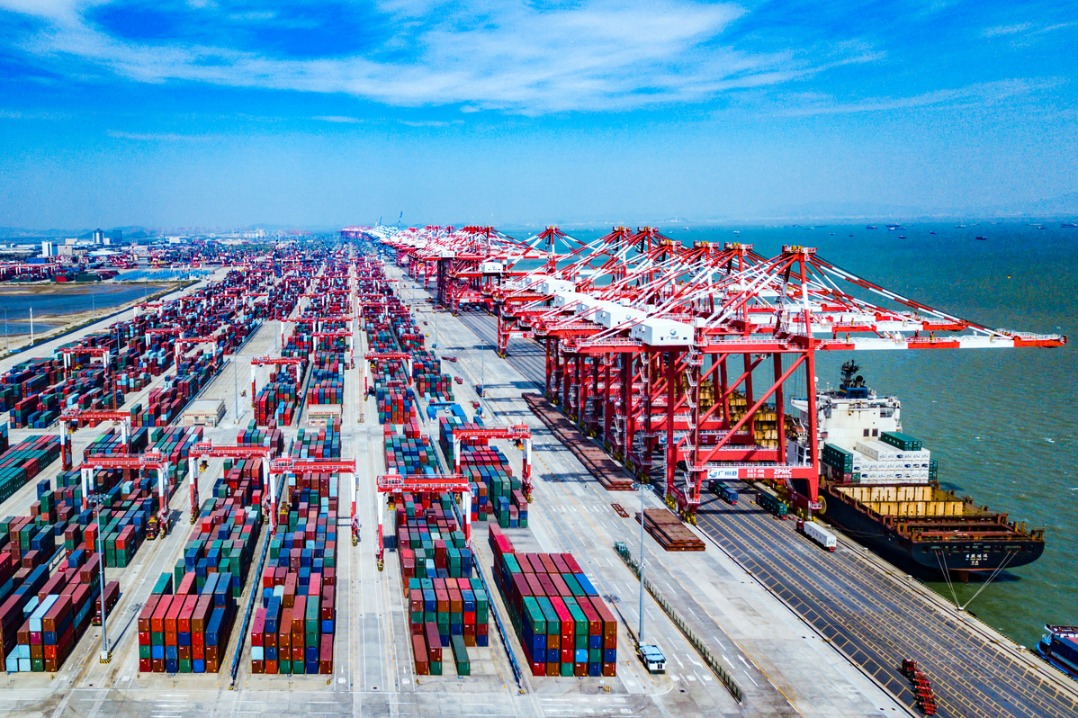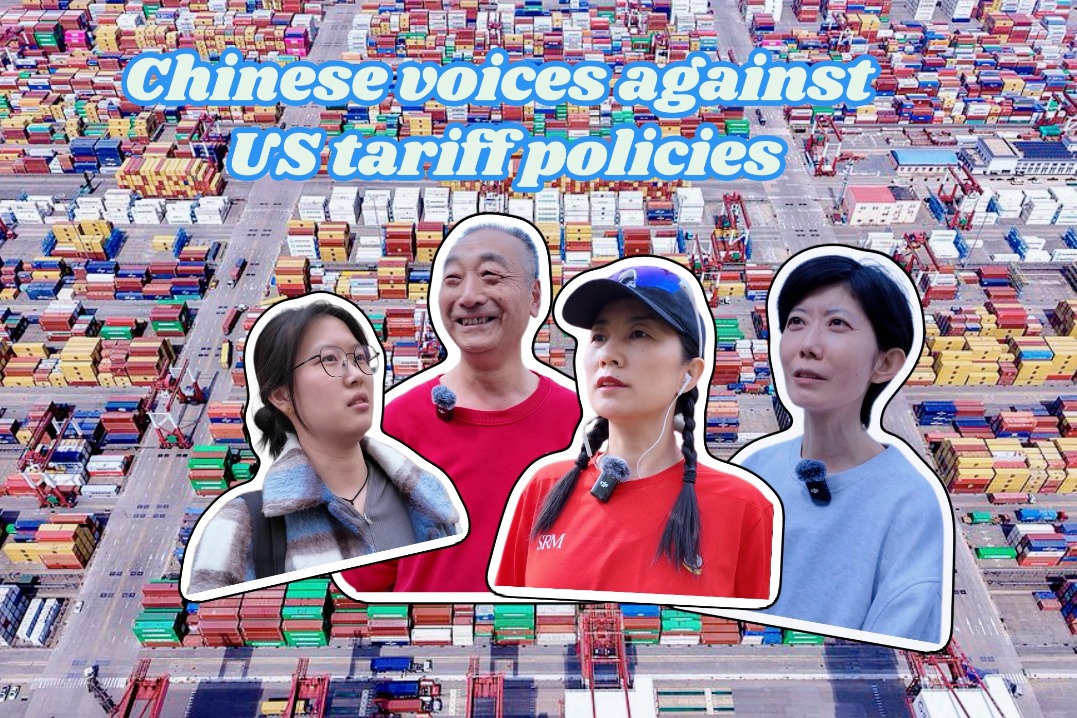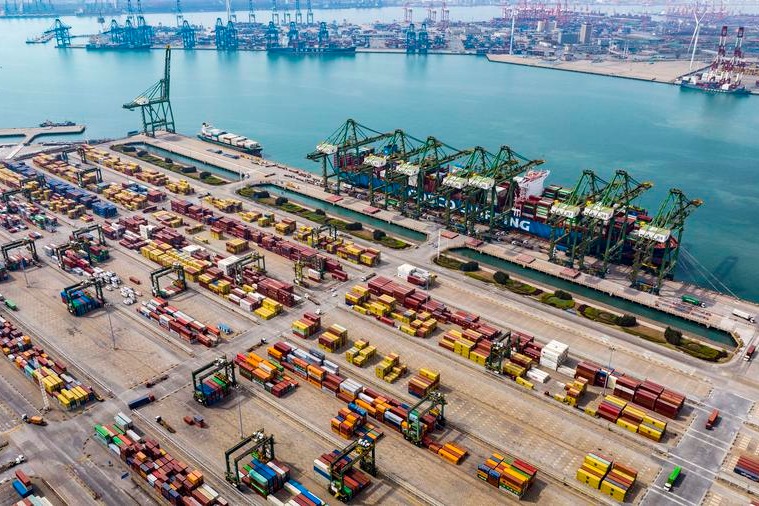Express deliveries reshape lives, convenience in rural areas
Expansion of e-commerce services increases availability of products


Born and raised in Ganjiang, a rural village in Northwest China's Gansu province, Xie Ruiling first encountered online shopping around 2010, when she and her husband were employed as migrant workers in Tianjin, a bustling northern city.
"In Tianjin, everyone around me was buying everything online, so I decided to give it a try. I ordered some skin care products," Xie recalled. "After I completed the payment, the products arrived at my doorstep in about four days."
The experience was eye-opening. "The platform had so many options, and the prices were great. With little time to shop in stores while working, online shopping felt like a lifesaver."
What began as a one-time experiment quickly became a habit. Xie spent her free time browsing online stores and placing orders, continuing this routine when she returned to Ganjiang in 2017, pregnant with her second child.
However, life in the village wasn't as convenient. While cities like Tianjin already had 48-hour delivery services, Ganjiang still dealt with delays or "unable to deliver "notices. "Many stores showed messages like 'Area not supported for shipping' or 'Additional shipping charges apply'," Xie said. "Sometimes, the shipping fee was higher than the price of the product itself."
In Tianjin, Xie was used to receiving her orders in about three days. But in Ganjiang, the wait could stretch to five or six days, and sometimes, she had to drive to town to pick up her packages. "It was frustrating," she added.
But in 2024, everything began to change. "Now, I get free shipping all the time, and if the items are close by, they arrive in two days. If they're farther away, it's at most three or four days. It's so convenient now," Xie said.
Zhao Xiaohong, a fellow villager, noticed the transformation as well. "Express delivery and e-commerce have become essential parts of our lives," Zhao said.
"Whether it's the elderly or children, everyone is either picking up a parcel or heading out to collect one. Packages arrive so often that we sometimes have to queue at the delivery station."
In Ganjiang, the allure of city life has faded. "There are job opportunities right here, and whatever we want to buy online is delivered to our doorstep. We don't envy city living anymore," Zhao added.
What once seemed like a distant luxury has now become part of daily life in Ganjiang. As e-commerce and express delivery networks expand into remote parts of China, they are reshaping how people shop and live. For Xie, Zhao, and others in Ganjiang, receiving everything from daily necessities to special purchases has made rural life feel more connected to the world, bridging both physical and cultural distances.
Reducing the gap
The expanding parcel delivery network in China has reduced the gap between urban and rural areas, providing rural residents with access to urban commodities and facilitating the flow of agricultural products to cities.
Xie and Zhao's experience mirrors a larger trend across China, driven by the rapid growth of the country's parcel delivery sector. On Nov 17, 2024, China's parcel delivery industry reached a milestone, handling a record 150 billion parcels within a year. This marks the country's economic resilience and the efficiency of its logistics and e-commerce systems.
This surge in parcel deliveries highlights logistics' role in China's economy. In 2024, the average Chinese consumer is expected to receive over 100 parcels annually, with the country's delivery network processing more than 5,400 parcels every second.
"On one hand, China's express delivery industry ensures the well-being of the residents, while on the other, it stimulates production. This virtuous cycle contributes to economic growth and strengthens China's leadership in the global supply chain," said Zhao Guojun, director of the Postal Development Research Center at Beijing University of Posts and Telecommunications.
The rapid growth of China's express delivery sector is closely tied to the explosive expansion of its e-commerce market, which continues to drive demand for faster and more efficient delivery services. As the world's largest e-commerce market, China generates massive business for the logistics industry, with online shopping becoming a cornerstone of daily life for many.
According to a report released in 2022 by iResearch, a digital economy consultancy, over 80 percent of domestic express delivery packages in China are e-commerce products. The volume of e-commerce packages is projected to exceed 157.6 billion by 2027, accounting for approximately 81 percent of the total express delivery market, according to a report by ZTO Express last year.
However, the high cost of shipping to remote areas has long been a challenge, especially in western China. This bottleneck has prevented many rural consumers from enjoying fast, affordable deliveries. But by 2024, strides have been made to address this issue.
Shipping to remote areas
Since 2022, e-commerce platforms and logistics companies have pioneered a new "e-commerce transfer and centralized shipping" model to tackle the cost and logistical challenges of reaching remote areas.
Parcels destined for distant locations are first sent to transfer warehouses, like those in Xi'an of Shaanxi province, where they are sorted and then sent collectively to their final destinations by logistics providers. This collective shipping approach has significantly lowered delivery costs for e-commerce sellers, especially those hesitant to ship to western regions due to expensive logistics fees.
For example, a consumer in Xinjiang Uygur autonomous region will see their items shipped first to the Xi'an warehouse, where they are sorted and relabeled before being sent collectively to Xinjiang, reducing individual shipping costs. The final "last mile" is then handled by local networks, ensuring parcels reach remote villages.
An online store owner in East China's Anhui province who sells herbal tea across China experienced the difference firsthand. Previously, delivering a package from Anhui to western regions could cost up to 18 yuan ($2.46) per kg. Under the new system, shipping to Xi'an now costs just 2 yuan per kilogram, with an additional 3 yuan for the final delivery to Xinjiang.
In September 2024, Pinduoduo, one of China's top e-commerce platforms, launched its "Billion-yuan subsidy" initiative. This initiative covers the cost of logistics transfer fees for shipments from the transfer hubs to remote regions like Xizang autonomous region, Gansu, and Ningxia Hui autonomous region, allowing merchants to ship to these areas at costs similar to shipping to eastern China.
For instance, the herbal tea seller in Anhui now only pays 2 yuan per kg from Anhui to Xinjiang.
Consumers in remote regions are noticing the difference.
Xie Ruiling now enjoys free shipping on nearly all her purchases, and delivery times have improved further. "I receive my purchases in two to four days in most cases," she said.
The changes are also beneficial for consumers like Geng Bing in Xizang. He used to pay around 30 yuan to ship a car-top luggage box. Under the new system, his shipping costs were waived.
"By leveraging 'transfer hubs', the initiative has created a ripple effect that benefits three key areas. First, it reduces the additional logistics costs that consumers in remote areas would otherwise incur. Second, it expands the sales reach of e-commerce merchants to western and remote regions. Third, it brings an increase in e-commerce parcels, which further reduces the operational costs of express delivery services," said Xu Yong, vice president of the express logistics branch of the China Transportation Association.
"E-commerce platforms serve as a hub for merchants, product information, financial flow, and logistics, making them highly influential," he said, adding that the initiative has promoted win-win development for consumers, e-commerce platforms, and logistics services in western and remote regions.
E-commerce boosted in west
China has been investing in infrastructure to strengthen delivery networks in China's western regions, addressing longstanding barriers to e-commerce growth. Distribution centers are expanding, and transportation routes are being optimized to improve operational efficiency.
According to the State Post Bureau of China, since 2024, the regional development of the postal and express delivery industry has become more balanced, with the proportion of express deliveries in the central and western regions continuing to rise. The growth rate of business volume in these areas exceeds the national average.
Thanks to these improvements, products from remote western areas like melons from Changji, Xinjiang, yak meat from Nyingchi in Xizang, and red goji berries from Haixi, Qinghai province, are now delivered to consumers across China, opening up new markets for regional specialties.
This new commerce is stimulating local economies and making it easier for remote-area consumers to access a wider range of products.
Through the new shipping model, e-commerce platforms are reducing logistics costs, improving operational efficiency, and unlocking potential in underserved western and rural markets.
This is bridging the gap between eastern and western China, bringing the benefits of e-commerce and faster delivery to a larger population.
As express delivery continues to evolve, it has become an integral part of daily life in China. With an average of 100 parcels delivered per person annually, the country is experiencing an unprecedented reliance on parcel delivery services. It's no longer just about receiving a package; it's about how people live and shop, connecting rural areas to urban centers and making the world feel smaller.
Beyond the numbers, the personal connections formed between delivery drivers and customers are what truly humanize this booming industry.
On the last day of 2024, He Kaixin, a resident of Zhangzhou in East China's Fujian province, sent an online red envelop containing 50 yuan as a token to the courier who had been serving her for the past year.
She sent the red envelope with a message: "Thank you for delivering my packages to my doorstep all year. The elevator is often broken, and I know it must be tough carrying parcels up. Please take this to just enjoy a cup of milk tea on me."
The deliveryman politely declined, replying, "This is my job, it's what I do."
Though simple, his response reflected the pride workers take in their roles, no matter the challenges.
luowangshu@chinadaily.com.cn
























